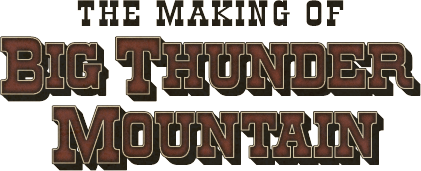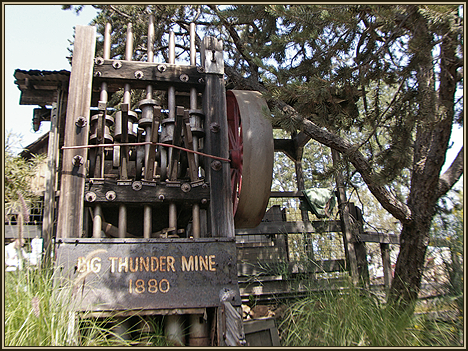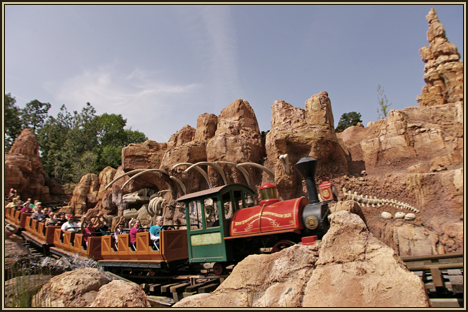
Nº 2 — California Gold
The Mine Train through Nature’s Wonderland, a Walt Disney-era scenic attraction in Disneyland California, was beginning to show signs of age. The fuel-powered trains moving slowly past Western wildlife scenes were becoming increasingly expensive to maintain while attracting fewer and fewer riders.
Disneyland management had seen the models for Tony Baxter’s runaway mine train ride and decided that it was just the thing they needed to replace the aging attraction.
Changes had to be made to the original concept, in order to make it fit: Not only was the scale of both parks vastly different, but at Disneyland the ride would be set right next to Fantasyland where the rugged Monument Valley-inspired buttes would have looked out of place.

Concept art by Tony Baxter. © Disney.
As Tony Baxter and his team were working to scale down the proposed scenery, they happened across images of Bryce Canyon, Utah… The softer, more fanciful rock formations (called “hoodoos”) of this natural amphitheater looked perfect for what the Imagineers had in mind: a landscape equally at home in the West as in an imaginative fairy tale setting. Rockwork expert Skip Lange designed the mountainscape, as he would for all subsequent incarnations of the ride.

The hoodoos of Big Thunder Mountain, California.
On the technical side, the roller coaster circuit was being laid out with the help of early ride engineering computer software. The computer, doing its best to ensure a smooth ride, first had to be convinced of the Imagineers’ point of view, however. Tony Baxter and his team, after all, wanted anything but a smooth ride; they wanted the trains to shake and rattle as they rushed along the spiraling track, heightening the excitement of the runaway train ride.
To provide this thrill ride with context, another Imagineer joined the team: John Patrick, or Pat, Burke. A show set designer for Walt Disney Imagineering, Pat would put his intimate knowledge of the American Southwest and its lore to good use when providing the attraction with a detailed back-story and dozens of antique props, in order to craft a truly convincing relationship between the ride and its setting.

John Patrick Burke and Skip Lange at work on the Bryce Canyon-inspired model. Photo provided by by John Patrick Burke.
The story Pat came up with centered on a Native American spirit or deity, the Thunderbird, who guarded over the mountain. When miners invaded the mountain and robbed it of its wealth, the Thunderbird would clap its wing, causing the earth to quake and mines to cave in… Riders would witness the consequences for themselves at the ride’s earthquake finale!
All this was of course based on existing Southwest mythology: “The Thunderbird God was found in an actual research book on Indian legends,” Pat notes. Cave-ins would frequently be attributed to the angered deity. “The Indians would then board over the mine shaft and cover it with mud and brush as if it had never been there.” A hundred years later, bikers would unwittingly come across vertical mine shafts that got this treatment. “I saw one of these bikes after a forty foot drop.”
In the Big Thunder Mountain story, these thundering earthquakes were soon joined by other bizarre phenomena; it wasn’t long before the Big Thunder Mountain Railroad’s mine trains were found leaving the stations without anyone at the controls… Finally convinced that the mountain was cursed, the mining company closed down its operations and the town of Big Thunder became one of many Western ghost towns.

Pat Burke scouted auctions, old abandoned mines, flea markets and real ghost towns across the West to furnish the ride and its queue line with authentic props and machinery. Items included a giant cogwheel, an 1880 stamp mill, steam engines and ore carts. A water tower of Pat’s design (seen below), with rotating buckets, reportedly inspired Steven Spielberg to include a similar device, among other mining equipment, in Indiana Jones and the Temple of Doom.

Further scenery was taken straight from the ride’s predecessor, the Mine Train through Nature’s Wonderland, most notably those buildings which would make up the town of Big Thunder, and part of the prominent dinosaur skeleton.

One particular detail which would gain more prominence in subsequent versions of the attraction has an interesting history as well, as Pat shares. The “BTM” logo, created as a one-off dimensional plaque by Imagineers of the graphics department, was actually designed with an upside-down W in place of the M…

…and TWB stands for none other than the ride’s creator Tony Wayne Baxter. “This originated on an air compressor in the Disneyland load building and was then added to the train engines in smaller form.”

The original plaque which was spawned subsequent applications of the Big Thunder Mountain logo. Photo by John Patrick Burke.
Big Thunder Mountain Railroad opened in September 1979 to great success… but the Imagineers had no time to rest on their laurels, as the management of Walt Disney World had had yet another change of heart — and commissioned their own version of the attraction, the same that Tony Baxter had designed years earlier.

| 
